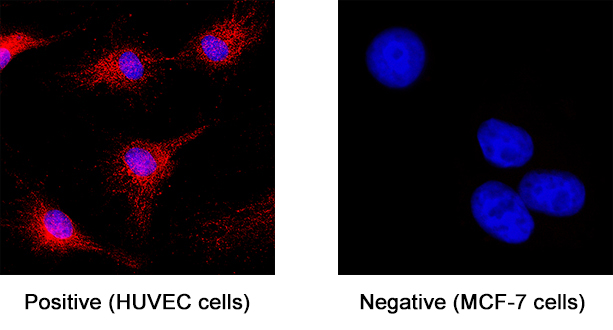Human ST2/IL-33R LlaMABodyTM Bivalent VHH HuIgG2 Fusion Antibody
Human ST2/IL-33R LlaMABodyTM Bivalent VHH HuIgG2 Fusion Antibody Summary
| Human ST2/IL-33R Specific Llama VHH domain | Llama Hinge | Human IgG2 |
| N-terminus | C-terminus | |
Lys19-Phe328
Accession # BAA02233
Applications
Please Note: Optimal dilutions should be determined by each laboratory for each application. General Protocols are available in the Technical Information section on our website.
Scientific Data
 View Larger
View Larger
ST2/IL-33R in HUVEC Human Cells. ST2/IL-33R was detected in immersion fixed HUVEC human umbilical vein endothelial cells (positive staining) and MCF‑7 human breast cancer cell line (negative staining) using Llama Anti-Human ST2/IL-33R LlamabodyTM Bivalent VHH HuIgG2 Fusion Monoclonal Antibody (Catalog # LMAB108591) at 8 µg/mL for 3 hours at room temperature. Cells were stained using an Anti-alpaca Alexa Fluor 594 (red) and counterstained with DAPI (blue). Specific staining was localized to cytoplasm. Staining was performed using our protocol for Fluorescent ICC Staining of Non-adherent Cells.
Reconstitution Calculator
Preparation and Storage
- 12 months from date of receipt, -20 to -70 °C as supplied.
- 1 month, 2 to 8 °C under sterile conditions after reconstitution.
- 6 months, -20 to -70 °C under sterile conditions after reconstitution.
Background: ST2/IL-33R
ST2, also known as IL-1 R4 and T1, is an Interleukin-1 receptor family glycoprotein that contributes to Th2 immune responses (1, 2). Human ST2 consists of a 310 amino acid (aa) extracellular domain (ECD) with three Ig-like domains, a 21 aa transmembrane segment, and a 207 aa cytoplasmic domain with an intracellular TIR domain (3, 4). Alternate splicing of the 120 kDa human ST2 generates a soluble 60 kDa isoform that lacks the transmembrane and cytoplasmic regions as well as an isoform that additionally lacks the third Ig‑like domain (4). Within the ECD, human ST2 shares 68% and 64% aa sequence identity with mouse and rat ST2, respectively. ST2 is expressed on the surface of mast cells, activated Th2 cells, macrophages, and cardiac myocytes (5-8). It binds IL-33, a cytokine that is upregulated by inflammation or mechanical strain in smooth muscle cells, airway epithelia, keratinocytes, and cardiac fibroblasts (5, 9). IL-33 binding induces the association of ST2 with IL-1R AcP, a shared signaling subunit that also associates with IL-1 RI and IL-1 R rp2 (1, 10, 11). In macrophages, ST2 interferes with signaling from IL-1 RI and TLR4 by sequestering the adaptor proteins MyD88 and Mal (7). In addition to its role in promoting mast cell and Th2 dependent inflammation, ST2 activation enhances antigen induced hypernociception and protects from atherosclerosis and cardiac hypertrophy (5, 12-14). The soluble ST2 isoform is released by activated Th2 cells and strained cardiac myocytes and is elevated in the serum in allergic asthma (6, 8, 15). Soluble ST2 functions as a decoy receptor that blocks IL‑33’s ability to signal through transmembrane ST2 (10, 13‑15).
-
Barksby, H.E. et al. (2007) Clin. Exp. Immunol. 149:217.
-
Gadina, M. and C.A. Jefferies (2007) Science STKE 2007:pe31.
-
Tominaga, S. et al. (1992) Biochim. Biophys. Acta 1171:215.
-
Li, H. et al. (2000) Genomics 67:284.
-
Schmitz, J. et al. (2005) Immunity 23:479.
-
Lecart, S. et al. (2002) Eur. J. Immunol. 32:2979.
-
Brint, E.K. et al. (2004) Nat. Immunol. 5:373.
-
Weinberg, E.O. et al. (2002) Circulation 106:2961.
-
Sanada S. et al. (2007) J. Clin. Invest. 117:1538.
-
Palmer, G. et al. (2008) Cytokine 42:358.
-
Chackerian, A.A. et al. (2007) J. Immunol. 179:2551.
-
Allakhverdi, Z. et al. (2007) J. Immunol. 179:2051.
-
Verri Jr., W.A. et al. (2008) Proc. Natl. Acad. Sci. 105:2723.
-
Miller, A.M. et al. (2008) J. Exp. Med. 205:339.
-
Hayakawa, H. et al. (2007) J. Biol. Chem. 282:26369.
Product Datasheets
FAQs
-
What are Camelid Antibodies?
Camelid antibodies are antibodies from the Camelidae family of mammals that include llamas, camels, and alpacas. These animals produce 2 main types of antibodies. One type of antibody camelids produce is the conventional antibody that is made up of 2 heavy chains and 2 light chains. They also produce another type of antibody that is made up of only 2 heavy chains. This is known as heavy chain IgG (hcIgG). While these antibodies do not contain the CH1 region, they retain an antigen binding domain called the VHH region. VHH antibodies, also known as single domain antibodies or Nanobodies®, contain only the VHH region from the camelid antibody.
Reviews for Human ST2/IL-33R LlaMABodyTM Bivalent VHH HuIgG2 Fusion Antibody
There are currently no reviews for this product. Be the first to review Human ST2/IL-33R LlaMABodyTM Bivalent VHH HuIgG2 Fusion Antibody and earn rewards!
Have you used Human ST2/IL-33R LlaMABodyTM Bivalent VHH HuIgG2 Fusion Antibody?
Submit a review and receive an Amazon gift card.
$25/€18/£15/$25CAN/¥75 Yuan/¥2500 Yen for a review with an image
$10/€7/£6/$10 CAD/¥70 Yuan/¥1110 Yen for a review without an image




